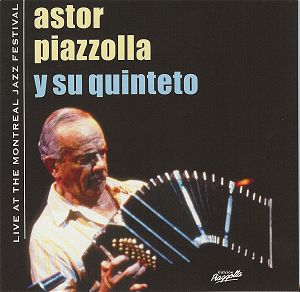1. Lunfardo
2. Muerte del Angel
3. Resurrección del Angel
4. Tristeza de un Doble A
5. Adiós Nonino
6. Chin Chin
7. Otoño Porteño
Astor Piazzolla – Bandoneón
Pablo Ziegler – Piano
Fernando Suárez Paz – Violin
Oscar López Ruiz – Electric guitar
Héctor Console – Double bass
A few days ago I reviewed
the Sydney Symphony Orchestra's Kaleidoscope
performance, subtitled "Latin American
Nights" and including Piazzolla's Concerto
for Orchestra and Bandoneón. I felt
drawn in that review to refer to the performance
of the Latin genre as 'ferocious' and when
considering this particular review, I again
find myself back there, not only for its self-reflexive
sound (Say it out loud. Ferocious -
it sounds like the wind roaring!) but for
the way that it indicates not only a constant
passion, but also a biting impact. The same
passion an actor draws upon when shouting
'Mambo' in Bernstein's West Side Story.
The passion of bebop in a club, cranked to
a level where the beginnings of the notes
burn a little. Piazzolla's music hits you
hard, no matter which way you look at it.
This is one of the many reasons he is affectionately
referred to as The Great Astor in his
home country. He is the heart of the new tango,
especially from an outside/European perspective.
To be slightly unorthodox,
I would like to start with the penultimate
piece, Chin Chin, and then move to
the piece right before that, Adios Nonino.
The reason behind this is because they are
the standout performances on this album. Not
purely for technical reasons, but because
of the way they encapsulate both the elements
of live improvised jazz and the tango traditions
Piazzolla comes from. The other tracks may
be perhaps seen as supporting members of a
cast of free-roaming beasts.
Chin Chin illustrates
the idea of ferocity, especially in a small
ensemble sense, showing that it is not sheer
polyphony which draws me towards this adjective,
but that it is, instead, the nature of the
piece itself and how it fits into the genre.
The performance begins with a few bars of
the fragmentary bandoneón melody before
being joined by sporadic percussion, piano
glissandos, incensed electric guitar and atonal
violin slides. It plays itself out in true
jazz form, with the instruments given space
to solo amongst the seemingly haphazard accompaniment
and then brought back into the recapitulating
head. The ferocious nature of the piece that
I refer to is best reflected in the open piano
solo which drifts further and further away
from the ensemble, growing in intensity and
beautiful chaos. Pablo Ziegler’s performance
is inspiring and obviously inspired, his inventions
never seem old or retired, constantly shifting
and thickening into an intimidating cacophony.
Then suddenly, with ease, he brings back the
tango rhythms, precise and full of intention
to round out the piece. Piazzolla’s greatest
strength in this piece is his ability to showcase
another musician. The melody begins with a
bandoneón focus and grows from that,
but the chaos draws us towards the piano.
A brilliant performance and a nice departure
from the traditional quintet showcase.
Adios Nonino is partly
well known for the history behind its composition.
The story goes that Piazzolla heard of his
father's passing and retreated to his room
in silence. After half an hour, from within
the room came the melancholy melody which
Adios Nonino begins with. But do not
mistake this story for one that leads to a
simple or pure nostalgia. This performance
in particular begins with an open piano solo
by Ziegler, which at times verges on the melancholy,
but it is far from simple. Rather, it draws
upon Piazzolla's melody, adding beautiful
and grandiose ornamentation. After almost
two and a half minutes, Piazzolla enters on
the bandoneón playing the opening line
to the melody, cleverly composed to finish
unresolved. As he holds the final note, the
suspense builds, holding steady and waiting
for the resolution. But where melancholy would
ordinarily take over to pour out the grief
Piazzolla must've felt after his father died,
the strings enter: heavy and raucous. A heavy
calculated stumbling that drives forward only
to hit you with yet another melancholy melody,
this time on solo violin. Perhaps this is
truly what Piazzolla wanted to hint at with
Adios Nonino, the manic nature of mourning
and the abrupt coming of death. But the melancholy
violin is not alone for long; it finds a communal
longing with the bandoneón. This solo
section is heart-wrenching; the shrill violin
draws you into a brittle grief that swirls
and lifts, uncertain but unmistakably emotionally
driven.
The rest of this recording
contributes to a collection of Piazzolla’s
better known pieces, including Muerte del
Angel and Resurrección del Angel.
These two pieces act as a nod towards a more
traditional arrangement, most probably because
of the nature of their composition, as part
of Piazzolla’s ‘Angel Suite.’ Muerte del
Angel (Death of the Angel) takes on the
sound of a traditional tango and the heavy
rhythmic motifs that are associated with the
genre, while Resurrecion del Angel
(Resurrection of the Angel) allows for yet
another solo exploration, this time by Fernando
Suarez Paz on violin. Also, this is possibly
one of the few pieces on the album that explores
the smooth chordal possibilities of the bandoneón.
This performance recording
is a wonderful introduction to the work of
Astor Piazzolla and the nuevo tango.
The recording itself is of an extremely high
quality, retains the atmosphere of a live
performance and the dynamic nuances that such
a situation brings forth. Not only was Piazzolla
in fine form, his quintet exceeds all expectations;
they are rhythmically and stylistically ‘in
tune’ with the genre and Piazzolla’s composition
from beginning to end. Live at the Montreal
Jazz Festival is a wonderful addition
to the record collection of both jazz and
classical fans.
Sam Webster
